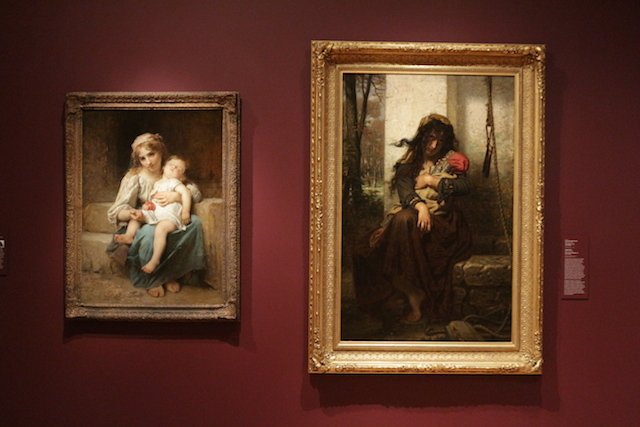The Lunatic of Étretat: Hysteria or Political Allegory?
By Claire Ferguson
First impressions of The Lunatic of Étretat (1871) almost overwhelmingly lend to interpretations of a deranged woman. In fact, the work’s circulation across social media platforms often see it identified as being emblematic of ‘female rage,’ madness, or mourning child loss. Such understandings are not unfounded, especially considering the lack of information surrounding the piece. The Lunatic of Étretat emerges unlike the rest of Hugues Merle’s artistic catalogue. Merle, a French painter of the Academic tradition, is best known for his sentimental subjects, with works like The First Thorns of Knowledge, and Maternal Love illustrating his Realist style. The Lunatic of Étretat, however, departs from this technique. The work, better described as belonging to the Romanticism movement, is set apart for its emotional intensity and dynamism.
Left: Léon-Jean-Bazile Perrault, The Orphans, 1888; Right: Hugues Merle, The Lunatic of Étretat, 1871, from inside The Chrysler Museum Virginia, photographed by Mostafa Heddaya
By far, the most compelling element of this painting is the woman’s gaze. The visible sclera of her eyes embodies a Japanese phenomenon known as ‘sanpaku,’ or ‘three whites.’ This term, introduced into English by George Ohsawa in the 1960s, carries a negative indication, as ‘sanpaku eyes’ are believed to represent imbalance and imply a dangerous future. This, coupled with the woman’s aggressive body language, contributes to a reading of the painting as one of anguish. Her knuckles, feet, and veins protrude, further indicating her distress. Her intense contortion indicates a readiness to flee, to withdraw herself from the viewer. Dressed in tattered clothing, and with hair flowing wild across her shoulders - she is unkempt. In her left arm, she clutches a wooden log. The log, which is wrapped in a blanket and tied with a bonnet, is cradled by the woman as if it were an infant. Many suggest the log performs as a surrogate for a child that has departed, or that it symbolizes her desire for motherhood. Each of these details points to a narrative of a delirious woman, a ‘lunatic.’ Caution should be taken, however, in such pathologisation. Contemporary interpretations of The Lunatic of Étretat often accept the woman’s condition as a consequence of her mental condition. This preconception has implications for historic notions of female hysteria and the invalidation of women’s health concerns. Reading this work as a gender-ridden commentary carries the risk of falling victim to similar presumptions.
Undoubtedly, The Lunatic of Étretat offers more layers to its interpretation than popular belief permits. Popular understanding neglects a crucial element of the painting’s history. The Chrysler Museum, which holds the work in its permanent collection, invites us to consider its allegorical meaning. The Chrysler’s accompanying text for the painting asks: ‘Could (Merle’s) dark image mirror the broader national mood of political loss and desolation?’ The work was completed alongside France’s defeat during the Franco-Prussian War in 1871 when they were ordered to surrender the territory to Alsace-Lorraine. With this context in mind, alternative analyses of the work are offered. The painting’s meaning transforms dramatically when the woman is considered the personification of France.
Hugues Merle, The Lunatic of Étretat, 1871, oil on canvas, 152.7 x 99.4 cm, The Chrysler Museum Virginia
This prompts us to consider the painting not as it relates to mental health, but instead as signaling a response to the artist’s political environment. Rather than being interpreted as deranged, Merle may be conveying an alternative message entirely. Her sanpaku eyes read, therefore, as insignia of the devastation that has already struck the country. France’s expression is resentful, irate, even. Her bodily contortion is further evidence of this, along with the straining of her fingers and knuckles. Her body language, rather than that of a mad woman, represents the anger of a devastated nation. Her twisted body signals the retaliation that France seeks against Germany and its allies. Her pseudo-infant signals the lost territory of Alsace-Lorraine. France guards the log baby with possessive fervour, representing her unwillingness to accept the recent political outcome. Rather than an unkempt woman, her flowing hair is a symbol of patriotism, mirroring her country’s blowing flag. The bonnet tied around the log, dyed red, represents the revenge flag which replaced that of France’s tricolour following the Paris Commune. Furthermore, Merle presents a juxtaposition in his depiction of France’s costume and her body. While her clothes are in poor condition, her hands and feet are clean and youthful. She exemplifies a strong country that, despite its defeat, will recover. She is not weak or delirious - rather, she embodies a powerful force that seeks retribution for its loss.
The lack of scholarship accompanying this work leaves viewers to derive their own analyses of The Lunatic of Étretat. While the popular reading of a deranged woman is not entirely unfounded, it is essential to consider the painting’s historical context and allegorical significance. Caution should be taken to avoid diminishing the figure to an emblem of lunacy. Such an approach threatens to bolster outdated notions of female hysteria. The work, complex and thought-provoking, offers many interpretations. The Lunatic of Étretat, when investigated further, provides an opportunity to challenge our assumptions and reconsider the layers of meaning in its composition.
Notes:
Chrysler Museum of Art. ‘The Lunatic of Étretat.’ [Accessed February 19, 2023] https://chrysler.emuseum.com/objects/56453/the-lunatic-of-etretat.
Jellinek, Frank, and Torr, Diana. The Paris Commune of 1871. (London: Victor Gollancz Ltd, 1937)
Winston, Leslie. ‘Seeing Double: The Feminism of Ambiguity in the Art of Takabatake Kashō’ in Rethinking Japanese Feminisms, edited by Julia C. Bullock, Ayako Kano, and James Welker (University of Hawaii Press, 2018): pp. 133–53.


